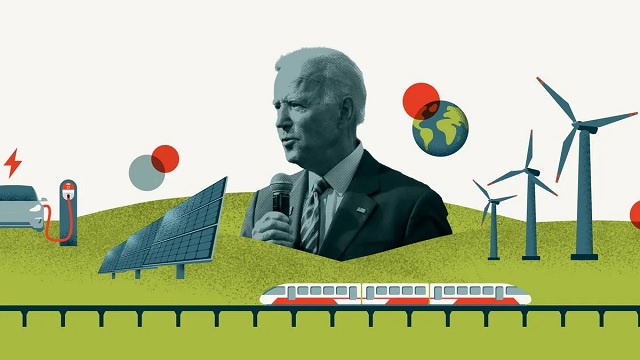The Incredible ‘Green Transition’ That Can’t

Joe Biden campaigned on getting rid of fossil fuels. He said he would ban fracking and his Green New Deal proposal would completely replace fossil fuels with clean energy by 2035. He is also on record saying he plans “an incredible transition” of the U.S. economy away from fossil fuels, openly admitting that pain at the pump from high gas prices is part of the plan. His administration is rushing pell-mell into a green energy future, by, among other things, drawing on the $27 billion green energy slush fund in the so-called Inflation Reduction Act.
There’s just one problem: the green energy future envisioned by the administration and other wild-eyed climate change fanatics is totally impossible and won’t ever happen.
There aren’t enough minerals on earth to make a green transition a reality. Copper, lithium, nickel, and cobalt are limiting factors, especially if you think about sustaining all-green energy into the future.
Converting all big trucks, ships, and railroads to electric – even if such a thing were possible – would require 10 times the number of power plants we have now.
To deliver reliable power from unreliable solar and wind, and avoid blackouts, would require more electrical storage capacity than is physically feasible or economically viable. Before we transition everything to green energy, wouldn’t it make sense to demand to see a demonstration project succeed, first? Of course it would. It’s also not too much to ask for a “comprehensive quantitative system-engineering life-cycle analysis of an all-renewable energy system” before we jump into it sight unseen. Such an analysis would include the costs of materials, construction, operation, maintenance, decommissioning, and disposal. And let’s see an environmental impact statement, while we’re at it. Green energy is incredibly damaging to the environment, as some on the Left are beginning to recognize. Life-cycle and environmental analysis would undoubtedly show a green transition is not physically or economically feasible.
Green energy fanatics have blinders on that don’t let them see beyond the east and west coasts. The fact is, regardless of what the U.S. does, worldwide use of coal set a record last year and is expected to increase further this year. The U.S. could do somersaults and cartwheels for green energy, but it wouldn’t make one bit of difference to global climate change computer models.
The fanatics want to leave fossil fuels in the ground and stop all oil & gas projects now, but the fact is fossil fuels will still be needed for decades if we are to avoid energy shortages, supply disruptions, and wild price swings.
Another problem is toxic waste. What are we going to do with all the obsolete wind turbines, defunct solar panels, and dead batteries a green transition would entail? No one has figured this out yet. Put them in landfills and toxic minerals will leach into groundwater. Burn them and it will all go into the air.
What happens to electricity prices if you get rid of all natural gas stoves, furnaces, and appliances and require everything to run on green energy? What happens to electricity prices if you get rid of the internal combustion engine and require all vehicles to run on batteries? Parts of Australia where gas drilling and fracking have been all but banned are already seeing double-digit increases. Consumers in U.S. states with renewable energy quotas pay higher energy prices than they otherwise would. Call it the ‘green tax’.
Vegetables are being rationed in Britain because soaring energy costs from overreliance on renewables is causing farmers to switch off their greenhouses before they go bankrupt. That’s just one consequence that flows from unchecked green mania – not enough greens to eat.
Not only would a green transition place upward pressure on electricity prices, there’s another problem, as identified in E.M. Forster’s magnificent short story The Machine Stops: once you centralize everything into one system, everything comes to a grinding halt when the system fails. A single point of failure – like an exclusively all-electric energy system – is a fundamental error well-known to anyone who has studied strategic planning. Move everything to electricity and everything will stop if electricity becomes unavailable or unreliable. That doesn’t happen now with energy sources for power and transportation diversified among coal, natural gas, oil, nuclear, and renewables. There’s a lot to be said for keeping energy diversity and not letting green energy mania put the blinders on. Our food, economic, and national security depend on it.
©Christopher Wright. All rights reserved.
Visit The Daily Skirmish and Watch Eagle Headline News – 7:30am ET Weekdays


Leave a Reply
Want to join the discussion?Feel free to contribute!